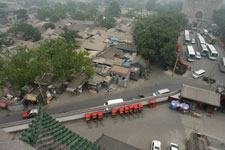
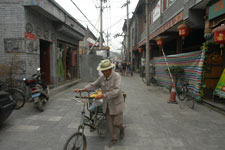
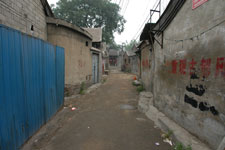
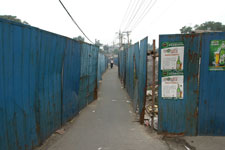
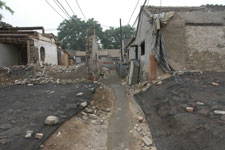
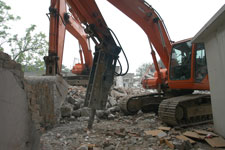
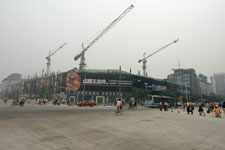
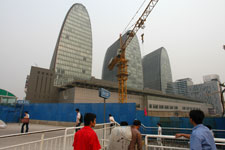
|
The "Imaging Beijing" project focuses on the demolition of traditional neighborhoods to make room for the "new" China. These neighborhoods, often referred to as hutongs have a rich history reaching back hundreds of years. The word hutong comes from the Mongolian hottog meaning "water well." During the growth of towns and cities, wells dug by villagers formed the centres of new communities. These days, the word hutong is generally understood to refer to the narrow streets or alleys of Beijing formed by rows of siheyuan, traditional courtyard residences. Many neighbourhoods were formed by joining one siheyuan to another to form a hutong, and then joining one hutong to another. Since these courtyard residences have no frontage other than a simple door, the experience of walking through a the hutongs of Beijing is like navigating a labyrinth of brick and plaster walls.
The Beijing work traverses a functional hutong through the demolition zone and into the construction sites where towers are being erected in anticipation of the 2008 Summer Olympics.
The Associated Press | Jul 28, 2007
Beijing Cracking Down on Rowdy Fans
BEIJING -- Fearful problems might spill over to next year's Olympics, Beijing officials are cracking down on sports fans who chant obscenities at opposing players and referees.
The move comes just days after Liu Qi, president of the Beijing organizing committee, called on local residents to improve their behavior with the Olympics just more than a year away.
"Everybody should cultivate good habits from now on," Liu told 1,600 people attending a rally on Wednesday. "Everybody should follow and protect public order, no matter if you are driving or walking. Clean words, clean environment and clean air. Clean up bad habits such as spitting, throwing rubbish and so on."
I usually begin a project with a derivation of the Situationists International's psychogeographic darivé or drift through the zone. The derive was defined by the Situationists as the "technique or locomotion without a goal." I try not to impose a subject on a place or enter the space with preconceptions of what is important there. I prefer to allow the place and people to tell their own story. This set of images captures the situation of the demolition of the hutongs emerging from this darivé.
Like all good darivés, one must be willing to become lost. This was particularly easy in the hutongs of Beijing. Although the north-south, east-west axis of the old city still structures the contemporary city, the air was often thick with smog and dust from the Mongolian dessert. It is rare to see shadows in June and the visibility usually did not exceed a few blocks. The hutongs would wined and narrow till all sense of orientation slipped away.
|








